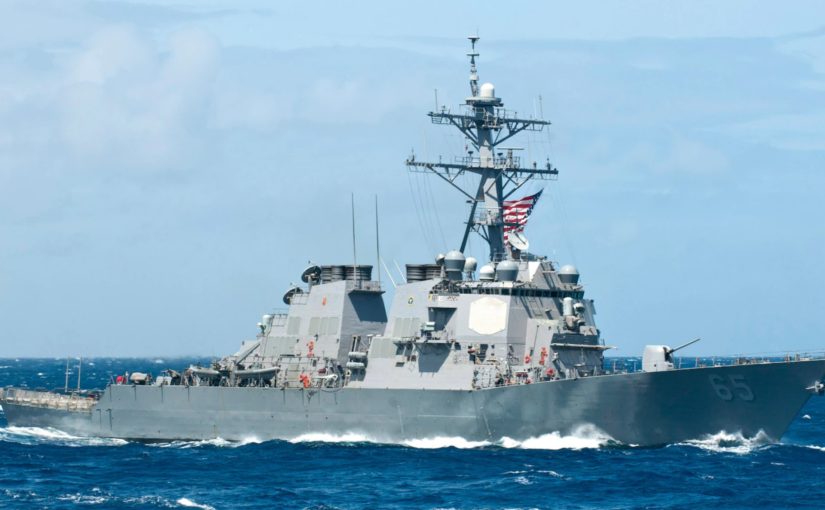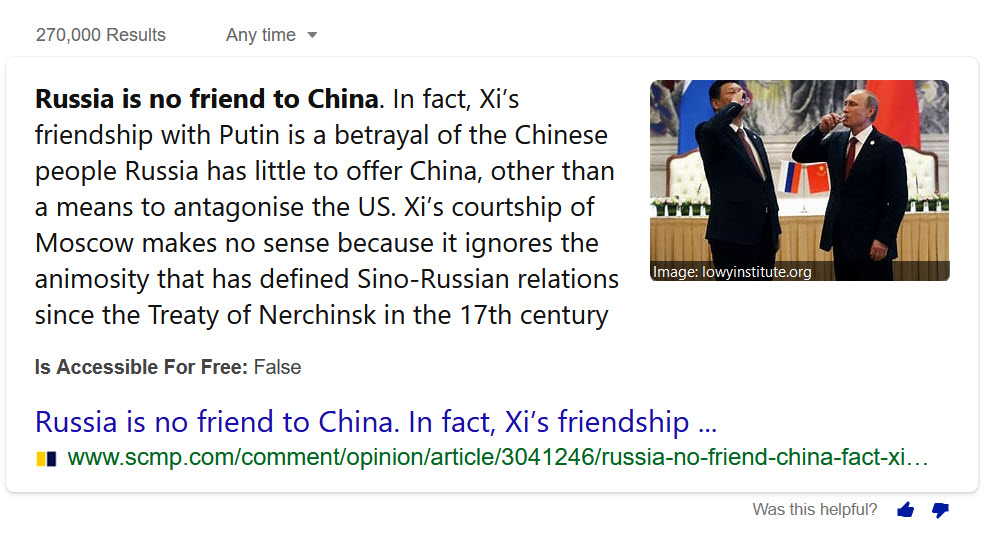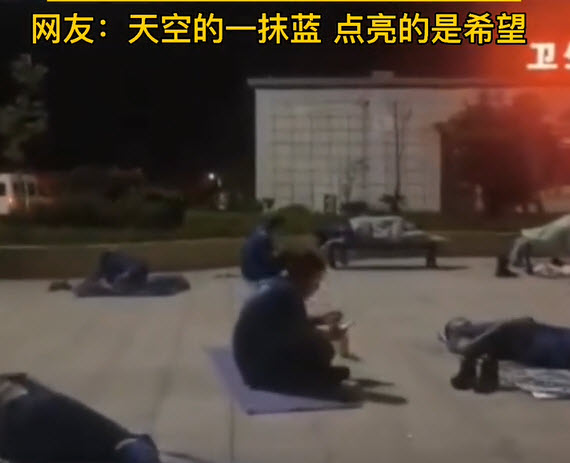The American news feeds are talking all about how President called Xi Peng of China. And that is all buried in the seemingly endless muck and grime that amounts to “news” in the West. But something else actually occurred. A United States Naval guided missile destroyer violated China’s 12 mile border and started conducting missile drills at one of the Chinese island Naval bases.
If you look at the time stamps, we see the following train of events;
- US Naval Destroyer violates the Chinese border.
- The Chinese military goes into full alert and “chases” the Destroyer away.
- The American “news” media denies that the entire event happened.
- The Chinese Navy then sends a flotilla between Taiwan and Japan.
- President Biden calls Xi Peng
Now you are NEVER going to see these events displayed in sequential order like I have presented here. Nor are you ever going to see any link between the actions of the US Navy off the Chinese coast, and President Biden.
But war is brewing, and America is becoming more and more provocative. It’s only a matter of time before missiles start flying.
What occurred?
From the Global Times.
The Chinese People’s Liberation Army (PLA) Southern Theater Command on Wednesday 8 September 2021 vowed to stay on high alert and safeguard China’s sovereignty and security, and protect peace and stability in the South China Sea, after it warned off a US destroyer that trespassed into Chinese sovereign waters in the region on the day, a few days after a US aircraft carrier entered the region for a provocative deployment.
On Wednesday, the US guided missile destroyer USS Benfold trespassed into areas adjacent to the Meiji Reef in the South China Sea without China’s permission, and the naval and aerial forces of the PLA Southern Theater Command conducted whole-process tracking and monitoring of the US destroyer and warned it off, said a PLA Southern Theater Command spokesperson in a written statement.
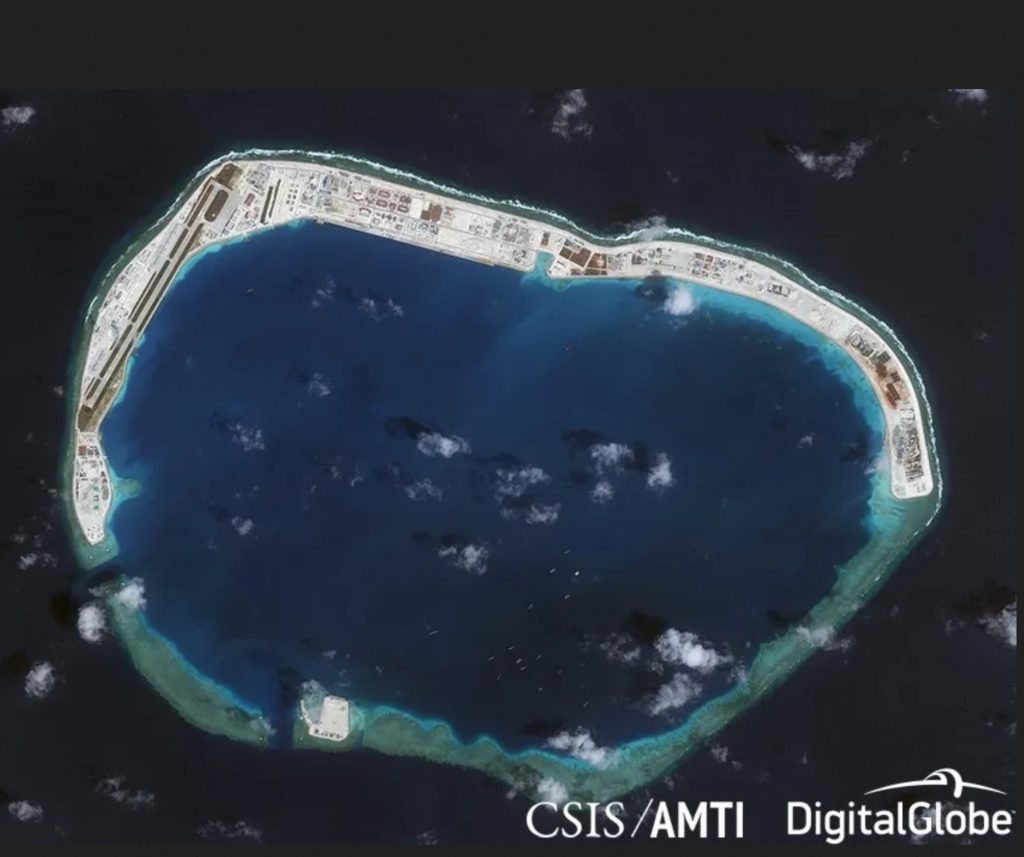
The spokesperson, Air Force Senior Colonel Tian Junli, pointed out that the US move seriously violated China’s sovereignty and security. It was the latest ironclad proof of US’ navigation hegemony and militarization of the South China Sea.
“More and more facts have proved that the US is the biggest risk maker and the biggest breaker of stability and peace in the region,” Tian said.
Tian stressed in the statement that China has sovereignty over the islands and nearby waters, and the troops of the PLA Southern Theater Command will stay on high alert. The troops will firmly perform their duties and missions to safeguard China’s sovereignty and security, and protect peace and stability in the South China Sea.
According to monitoring by the South China Sea Strategic Situation Probing Initiative (SCSPI), a Beijing-based think tank, the USS Carl Vinson aircraft carrier entered the South China Sea via the Bashi Channel on Monday. The carrier’s deployment was confirmed by the US Pacific Fleet later on Tuesday in a tweet.

It was the sixth time a US aircraft carrier entered the region this year, the SCSPI said.
Fu Qianshao, a Chinese military expert, told the Global Times on Wednesday that the US destroyer’s trespassing into Chinese sovereign waters and the US aircraft carrier’s deployment in the South China Sea are provocative moves aimed at China, and they could be coordinated with the UK’s HMS Queen Elizabeth aircraft carrier, which was operating near Japan.
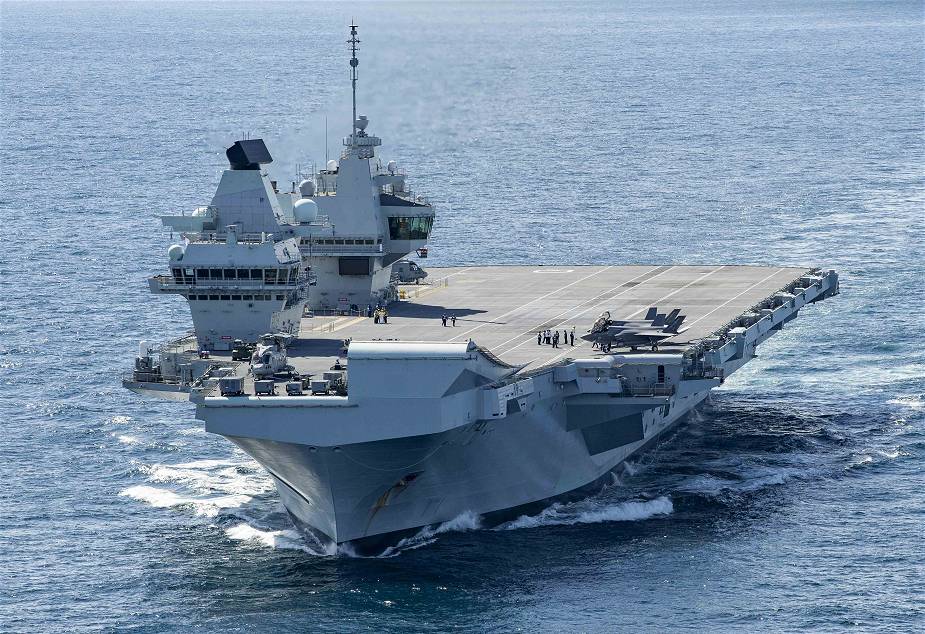
The USS Carl Vinson carried the US Navy’s first fully integrated air wing to deploy overseas with both the F-35C fighter and the new CMV-22B tiltrotor, according to a report published on August 2 on the website of the US Naval Institute.
As the first carrier to get the F-35C, the USS Carl Vinson went straight to the South China Sea with the aim of deterring China, but China has already developed a number of anti-stealth radar systems, so the F-35C can be detected, Fu said, noting that China also has countermeasures against the vertical take-off and landing-capable CMV-22Bs, which could land on islands and reefs in the region.
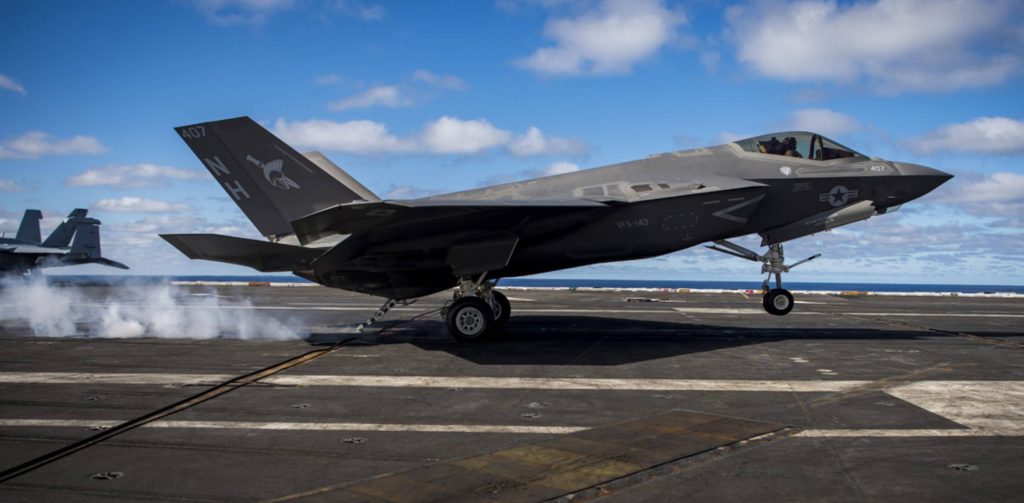
China is fully capable of and confident in dealing with such provocations, Fu said. “The PLA cannot be defeated within the second island chain.”
The American excuse…
Sep 08, 2021 · Sept. 8 (UPI) -- USS Benfold conducted a freedom of operation exercise near the Spratly Islands in the South China Sea to uphold the rights, freedoms and lawful uses … USS Benfold asserts freedom of operation in South China
And…
The U.S. Navy is disputing a claim from China that it chased an American warship out of the South China Sea after the U.S. vessel performed a freedom of navigation exercise. USS Benfold (DDG-65) on Wednesday sailed near the Spratly Islands – which China has staked a claim to – according to a news release from U.S. 7th Fleet. The People’s Liberation Army (PLA) quickly criticized the FONOP and claimed it chased the U.S. guided-missile destroyer out of the waters, according to a report in state-owned media outlet CGTN. Tian Junli, a spokesman for the PLA’s Southern Theater Command, said it “remain[s] on high alert,” CGTN reported. The U.S. Navy denied China’s claim and maintained it performed the FONOP within the constructs of international law. “The PRC’s statement about this mission is false. USS Benfold conducted this FONOP in accordance with international law and then continued on to conduct normal operations in international waters. The operation reflects our commitment to uphold freedom of navigation and lawful uses of the sea as a principle. The United States will continue to fly, sail, and operate wherever international law allows, as USS Benfold did here. Nothing PRC says otherwise will deter us,” 7th Fleet said in a statement. “The PLA(N)’s statement is the latest in a long string of PRC actions to misrepresent lawful U.S. maritime operations and assert its excessive and illegitimate maritime claims at the expense of its Southeast Asian neighbors in the South China Sea. The PRC’s behavior stands in contrast to the United States’ adherence to international law and our vision for a free and open Indo-Pacific region. All nations, large and small, should be secure in their sovereignty, free from coercion, and able to pursue economic growth consistent with accepted international rules and norms.” Benfold’s FONOP comes shortly after a new Chinese law that calls for ships carrying certain materials to provide specific information, like their call signs, went into effect, according to a recent report in CNN. -Destroyer Performs FONOP, U.S. Navy Disputes Chinese Claim That It Ousted Warship
Ah. It sounds so reasonable…
“The PLA(N)’s statement is the latest in a long string of PRC actions to misrepresent lawful U.S. maritime operations and assert its excessive and illegitimate maritime claims at the expense of its Southeast Asian neighbors in the South China Sea. The PRC’s behavior stands in contrast to the United States’ adherence to international law and our vision for a free and open Indo-Pacific region. All nations, large and small, should be secure in their sovereignty, free from coercion, and able to pursue economic growth consistent with accepted international rules and norms.”
But it is a lie.
The United States REFUSED to sign the international maritime agreements. As well as recognizing the sovereignty of the 12 mile limit around Chinese land.
The USA government requires a dumbed-down population to exist
As we used to say in the ‘States, “Don’t piss on my legs and tell me that it is raining”. Let’s take a look at a globe to see what is going on.
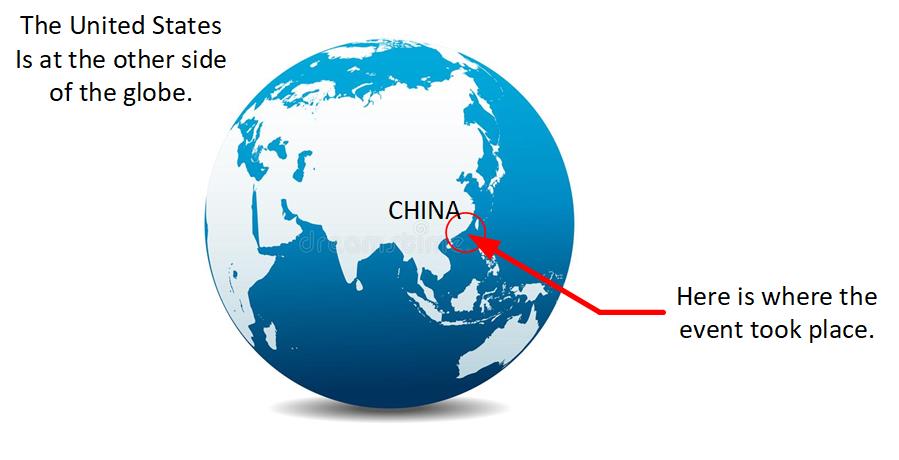
The excuse is that the United States is conducting “freedom of navigation” exercises near major shipping lanes. Granted you can’t get any closer than outside the Chinese port of Qingdao. But that is why the Chinese have their own Coast Guard. They don’t need American military warships sailing up and down the Chinese coastline.
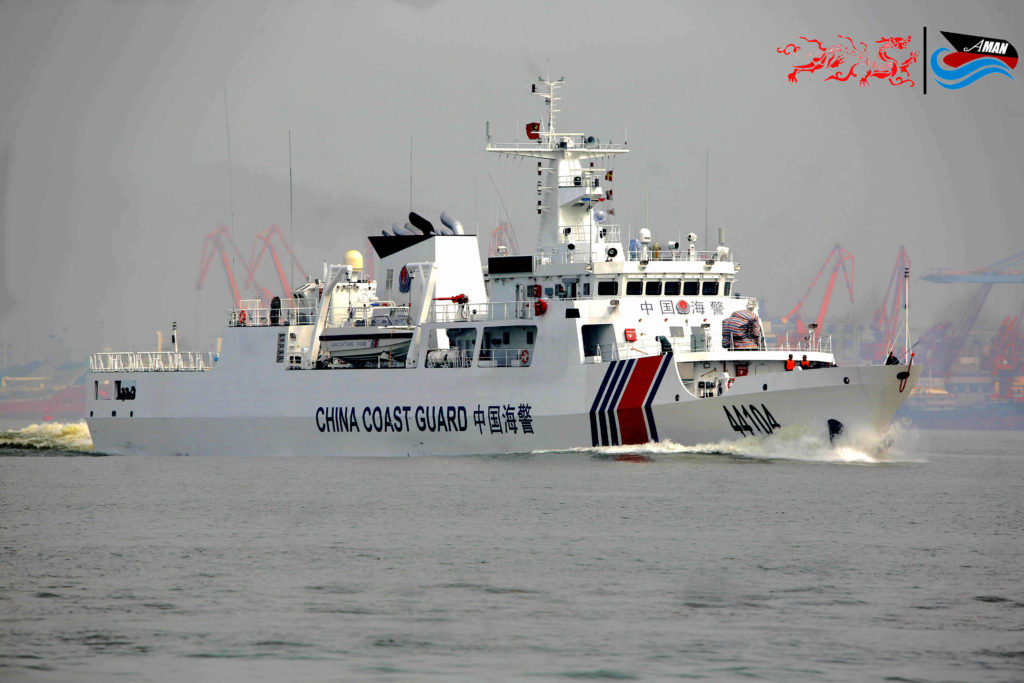
Then China sent their flotilla to Japan
A flotilla of destroyers, of the same equivalency of the American destroyer that violated Chinese national borders sailed to Japan from Taiwan.
From HERE.
A destroyer flotilla of the Chinese People’s Liberation Army (PLA) reportedly sailed in the waters between the island of Taiwan and some islands of Japan in the past week. Chinese analysts said the move sent a warning to Japanese right-wing forces and Taiwan secessionists, at a time when the two have been colluding to sabotage peace and stability in the region.
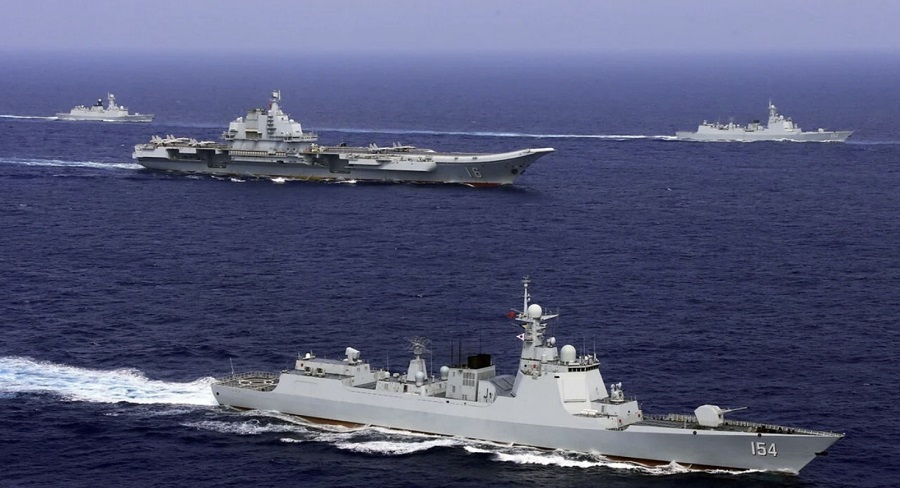
The Japan Maritime Self-Defense Force spotted a PLA Navy flotilla consisting of the Type 052D destroyer Zibo and the Sovremenny-class destroyer Hangzhou, as they sailed through the Miyako Strait, which is between Okinawa Island and Miyako Island, and then headed south into the Pacific Ocean on September 3, according to a press release from Japan’s Ministry of Defense Joint Staff on Wednesday.
On Sunday, these warships joined up with the Type 052C destroyer Zhengzhou and sailed north through the waters between Island of Taiwan and Yonaguni Island, returning to the East China Sea, the Japanese press release said.
While Japan claimed to have deployed forces to monitor the Chinese naval movements, the Japanese forces failed to obtain a photo of the Hangzhou or the Zhengzhou.
On August 24, another PLA naval flotilla sailed through the Miyako Strait, but it returned by the same route on August 26, according to press releases by Japan’s Ministry of Defense Joint Staff at the time.
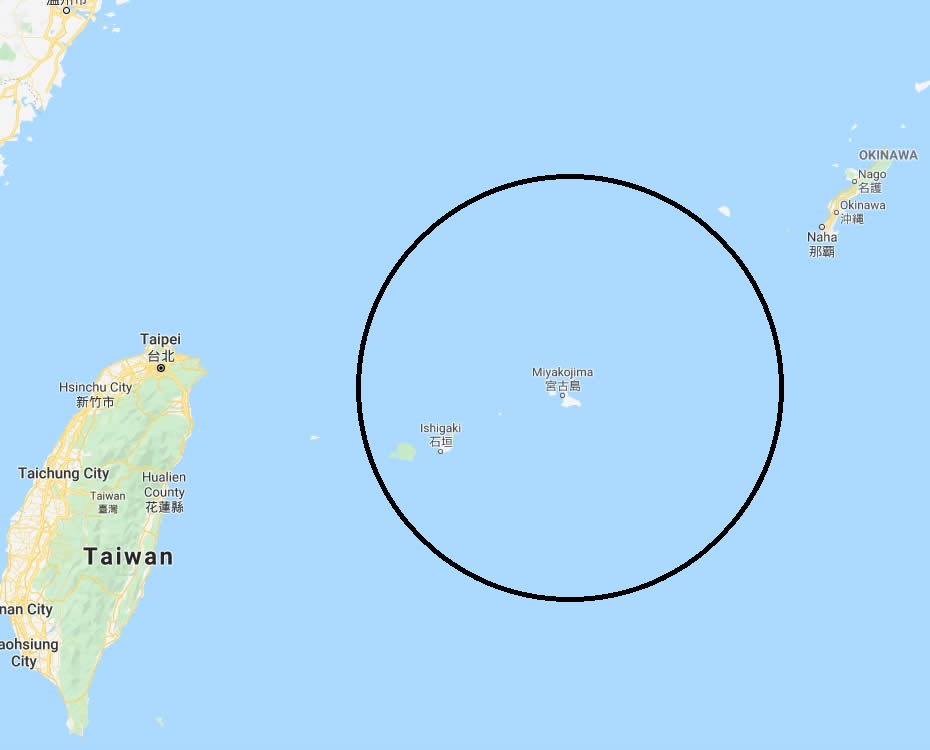
Japanese Defense Minister Nobuo Kishi claimed in an interview with the Mainichi Shimbun on Tuesday that Japan could not stay outside developments in Taiwan as both shared universal values such as freedom and democracy, Taiwan News reported on the day.
Japan’s latest defense white paper, released in July, for the first time mentioned stability in the Taiwan Straits, claiming it is “threatened by increasing military pressure from the Chinese mainland.” The white paper also said that “stabilizing the situation surrounding Taiwan is important for Japan’s security and the stability of the international community.”
Analysts said that Japan is using the Taiwan question to normalize its military deregulation and break its pacifist constitution, while also sending a wrong signal to Taiwan secessionists who are encouraged to make more provocative moves.
The PLA warships displayed China’s determination and capability to countries like Japan and the US, which attempt to interfere in the Taiwan question, Xu Guangyu, a senior adviser to the China Arms Control and Disarmament Association, told the Global Times on Thursday.
The moves will help safeguard peace and stability in the region by deterring Japanese right-wing forces and Taiwan secessionists, Xu said.
In the meantime, China does not need to regard Japan as so important that it reacts to every provocation militarily, since Japanese authorities have their own agenda like the election, Xu said, noting that the PLA should develop at its own pace.
On Sunday, the day that the three PLA warships returned to the East China Sea from the east of the island of Taiwan, 19 PLA aircraft, most of them fighter jets and bombers, entered Taiwan’s self-proclaimed southwest air defense identification zone, the island’s defense authorities said in a press release that day.
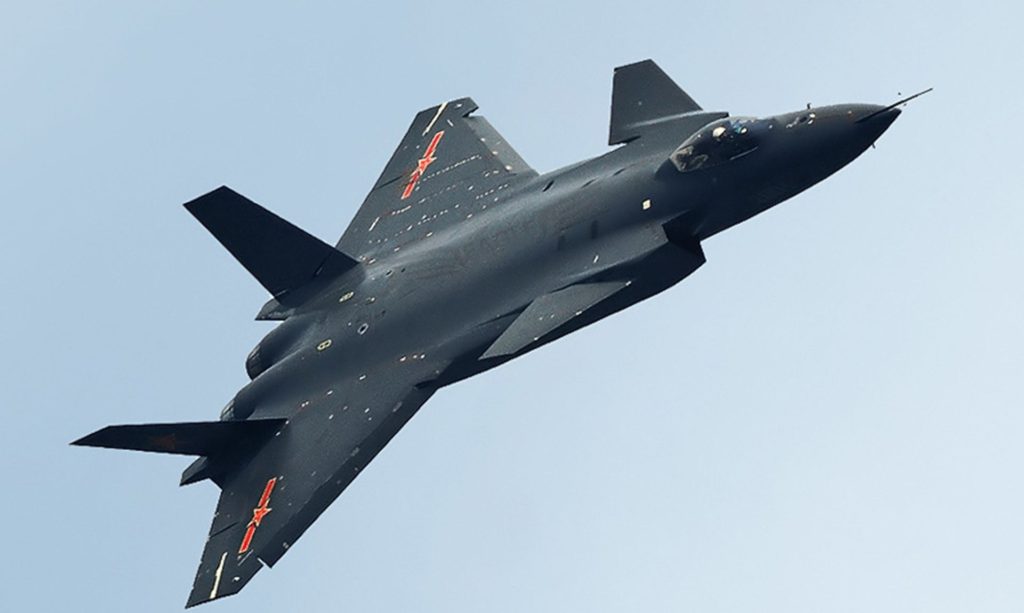
Why is this event important?
The destroyer committed an act of war. Violation of Chinese air, land or sea borders is one of the “Red Lines” that must not be violated or China will react in the HARSHEST MANNER POSSIBLE.
- China established “red lines” that if crossed will initiate a full scale war.
- The United States military sailed all the way to the other end of the globe to cross one of those red lines.
Then…
- Chinese Navy chased the American destroyer out of China.
- The Chinese Navy sailed a flotilla of destroyers to Japan.
Then…
- President Biden scrambled to the “Hot Line” and talked to the Chinese president Xi Peng immediately.
Why did President call Xi Peng immediately afterwards?
It wasn’t for global warming, lifting of trade tariffs or any of the other excuses that you read about in the American “news”. The timing of the call betrays it’s function.
President Biden called Xi Peng to diffuse a crisis.
Xi holds extensive strategic communication with Biden
From HERE. It differs substantially from the narrative in the American “news”.
BEIJING — Chinese President Xi Jinping on Friday morning took a phone call from his U.S. counterpart, Joseph R. Biden, and the two leaders had candid, in-depth and extensive strategic communication and exchanges on China-U.S. relations and relevant issues of mutual interest.
Noting that China and the United States are respectively the biggest developing country and the biggest developed country, Xi pointed out that whether they can handle their relationship well bears on the future of the world, and it is a question of the century to which the two countries must provide a good answer.
With the international community facing many common challenges, China and the United States need to show broad vision and shoulder great responsibilities, he said, adding that the two countries should look ahead and press forward, demonstrate strategic courage and political resolve, and bring China-U.S. relations back to the right track of stable development as soon as possible for the good of the people in both countries and around the world.
On the basis of respecting each other’s core concerns and properly managing differences, the relevant departments of the two countries may continue their engagement and dialogue to advance coordination and cooperation on climate change, COVID-19 response and economic recovery as well as on major international and regional issues, Xi said.
In the meantime, the two sides may tap more potential of cooperation to inject more positive dynamics into the relationship, he added.
For his part, Biden said that the two countries have no interest in letting competition veer into conflict, and that the U.S. side has no intention to change the one-China policy.
The U.S. side, he added, is prepared to have more candid exchanges and constructive discussions with China to identify key and priority areas where cooperation is possible, avoid miscommunication, miscalculation and unintended conflict, and get U.S.-China relations back on track.
Why is this entire event serious?
With the entire US Navy making aggressive incursions all over the South China Sea, it’s only a matter of time before a serious and dangerous incident will occur. This event tells us what is going on, and only two (viable) answers are available to us.
- Biden ordered the Naval Destroyer to intentionally provoke China.
- The Captain of the US Naval Destroyer took his own initiative to engage China.
If the event was planned by Biden to begin with, then why did he call Xi Peng immediately afterwords? It’s very hard to come up with an answer. What it means is that Present Biden intentionally is poking China to push a lethal response.
However, if the Captain of the Naval Destroyer took it on his own initiative, then this means that the US Military are operating autonomously, and dangerously.
Both scenarios are terribly dangerous and alarming.
There is a third possibility.
The United States Naval Vessel got lost and almost rammed into a Chinese island by accident. But that scenario is disturbingly upsetting, and so I have already discounted it.
What China thinks – 1
From HERE.
US Guided-missile destroyer USS Benfold trespassed in waters near the Meiji Reef in the South China Sea Wednesday without permission from China.
The Chinese side mobilized aircraft and ships to warn off and expel the ship from the waters.
In a 7th Fleet news release, the US side acknowledged that USS Benfold sailed within 12 nautical miles of Meiji Reef.
But it said the warship was asserting “navigational rights” and “freedoms”.
It claimed the Meiji reef “is not entitled to a territorial sea under international law,” and “the land reclamation efforts, installations, and structures” built on the reef “do not change this characterization under international law.”
China and the US don’t agree on the nature of the 12 nautical miles of Meiji Reef. Other different views exist worldwide. But international law doesn’t empower any country to challenge others’ sovereign claim with an intrusion by a warship.
The US in particular has no right to do so given the fact that it has not ratified the United Nations Convention on the Law of the Sea.
What the US has done is a naked provocation, and this is obvious to all.
There are many Chinese people and facilities on Meiji Reef, and the US warship that sailed so close to it apparently posed a threat. The Chinese side cannot remain indifferent, but must take countermeasures.
This is common sense.
The US policy to make waves in the South China Sea and instigate Vietnam and the Philippines to confront China has failed. It has become so exasperated that it crazily dispatched a warship to assert so-called freedom of navigation and trespass within 12 nautical miles of the Chinese reef.
The US warship came from afar to make provocations nearby the Chinese reef.
It was in fact a declaration of the US hegemony. The conditions for such an action are that only Washington has the strength to do so, and even if other countries are upset, they can do nothing but bear the US’ abuse of its hegemony. However, China has become stronger, which has undermined the above mentioned conditions.
Therefore, the US provocations in the South China Sea are not only a hegemony declaration but also aim at strategically suppressing China. With China’s approaches and abilities to resist such pressure growing, the risks that such US provocations will spark a maritime friction between China and the US will become higher and higher.
If Chinese warships go to US military bases in the Asia-Pacific and the US allies’ coastlines to conduct close-in reconnaissance operations and declare freedom of navigation, and if South China Sea claimant countries also conduct such operations around islands and reefs occupied by other parties, will the world’s maritime order be better or more chaotic?
Simply telling the truth to the US is not enough for China.
China needs to take active actions and speed up the establishment of its ability to conduct close-in reconnaissance operations on the above-mentioned bases and coastlines. The rapid development of China’s blue-water navy has made this possible.
Only by making the US have a taste of its own medicine can we touch the nerves of the US and its allies, and reshape the Western world’s understanding of US bullying in the South China Sea.
The US has deliberately provoked disputes in the South China Sea, and it must in turn endure the PLA’s increasingly strong countermeasures against it.
The game between the two sides will continue to go to an extreme.
The US will definitely see the PLA show up at its doorstep in the not-too-distant future. And together with China, the US will face the uncertainty which is increasingly difficult to control – the two sides’ warships and aircraft on the seas will carry huge mutual strategic hostility, and the two countries will not yield to each other.
If the situation goes on like this, there will sooner or later be an incident between China and the US in the South China Sea.
The US is the greatest threat to peace in the South China Sea, and it may eventually ruin the peace in the region. This is not just alarmist talk.
While China is competing with the US at sea, it must also make preparations for military frictions when the two sides fail to control their disputes, as well as the possible large-scale military conflicts afterwards. Once the situation gets out of control and triggers military clash between China and the US, we must give full play to our home field advantage. China will definitely win once there is a war.
What China thinks – 2
From HERE.
According to British newspaper the Financial Times on Saturday, Washington is seriously considering a request from the island of Taiwan to change the name of its mission in the US capital from “Taipei Economic and Cultural Representative Office” to “Taiwan Representative Office.” It is also reported that White House Asia adviser Kurt Campbell has backed the request. Washington is assessing the risks such a change would bring. The report has caused strong repercussions in the island, but neither the US government nor the Taiwan authorities have commented on the report.
Reports also said senior “national security” officials from the US and the island of Taiwan held face-to-face talks on Friday in Annapolis, Maryland, which is less than an hour’s drive from Washington DC. The two pieces of news were revealed immediately following reports about a phone conversation between the Chinese and the US heads of state.
It must be pointed out that if the US and the island of Taiwan do make the name change, it will mean Washington’s basic abandonment of its “one-China policy,” which will constitute a significant change surrounding the Taiwan question. Lithuania previously said it would set up an office in the Taiwan island with the name “Taiwan Representative Office” and the island also announced its plan to set up an office in Lithuania using the same name. This has met strong resistance from the Chinese mainland. If the US does the same, without doubt it will have a widespread demonstration effect on its allies and bring about a wave of name changes of the island’s mission in these countries.
The US knows well it’s a significant and serious matter. It is leaking certain information to test the Chinese mainland’s response. But, is there really anything to test? The Chinese mainland has no other choice but take the challenge and prepare for a showdown with the US if it pushes the matter to the tipping point of a showdown. Should the US rename the island’s mission in Washington as “Taiwan Representative Office,” the Chinese mainland should respond to it in a punitive way no lighter than it did with Lithuania. At that time, it’s anticipated that China will recall its ambassador to the US and it is likely the “lowest diplomatic reaction.” Otherwise, China cannot set up its prestige on the one-China principle it has always been upholding.
Due to US incitement and instigation, some Western countries are itching to play the “Taiwan card.” Punishing only small countries while ignoring the major powers won’t work. Safeguarding the bottom line of the one-China principle means we have to deter the US attempt to cross the line. Otherwise, we will have to face the possibility of more “Taiwan Representative Offices” emerging in a batch of capital cities.
Diplomatic measures alone are obviously not enough. If the US and the Taiwan island change the names, they are suspected of touching the red line of China’s Anti-Secession Law, and the Chinese mainland will have to take severe economic and military measures to combat the arrogance of the US and the island of Taiwan. At that time, the mainland should impose severe economic sanctions on the island and even carry out an economic blockade on the island, depending on the circumstances.
Militarily, Chinese mainland’s fighter jets should fly over the island of Taiwan and place the island’s airspace into the patrol area of the PLA. This is a step that the mainland must take sooner or later. The name change provides the Chinese mainland with sufficient reason to strengthen our sovereign claim over the island of Taiwan. It is anticipated that the Taiwan army will not dare to stop the PLA fighter jets from flying over the island. If the Taiwan side dares open fire, the Chinese mainland will not hesitate to give “Taiwan independence” forces a decisive and destructive blow.
More importantly, if the Chinese mainland turns a blind eye to the US and the Taiwan island this time, they will definitely go further in the next step. According to reports, Joseph Wu, leader of the external affairs of the Taiwan island, participated in the talks between senior security officials from the US and the island in Annapolis on Friday. Next time, they may publicly hold the meeting even in the US State Department in Washington DC. As the US will hold the “Summit for Democracy” by the end of this year, if we do not contain the insolence of the US and the Taiwan island, Washington might even really invite Tsai Ing-wen to participate in the summit. It will be much worse in nature than former Taiwan regional leader Lee Teng-hui’s visit to the US as an “alumnus” in 1995.
Will peace come if the Chinese mainland puts up with all this and swallows its anger for the sake of peace? If the mainland doesn’t strike back decisively, US warships will dock at the island of Taiwan, its fighter aircraft will land on the island and its troops may be stationed in the island again. At that time, where will be China’s prestige as a great power? How can the country maintain its system of defending its interests on the international stage?
The fact is that a contest of will has been formed regarding the Taiwan question Since China has declared that the Taiwan question is a matter of our core interests, we must take resolute actions to protect the bottom line of this exact national interest at any cost. If the Democratic Progress Party authority really dares to take the risk of triggering a war to push for a name change, and the US, which just suffered a debacle in Afghanistan, is not afraid of being involved in a new war, then what is there for the mainland to be scared of?
It seems that sooner or later, the Taiwan Straits will be plunged into a storm that will change the situation there drastically. And judging from the current actions of the US and the island of Taiwan, we can be sure that even if they will have to take this step back, they will step forth again soon. Thus, right now we need to be fully prepared to blow them out of the water in the Taiwan Straits.
The US has been engaging in phrase mongering, hoping that the “competition” between China and the US will not evolve into a “conflict.” We have to tell them clearly with our actions that “competition” with the Chinese mainland on the Taiwan question is bound to turn into a serious conflict, and there is absolutely no room for maneuver.
History tells us what’s next…
Remember, world war III, and inter Washington DC coups, will not be televised.
The fall of the Soviet Union occurred when the Military generals tried to take control of the government. From HERE.

Just on the morning of August 22, 1991, an Aeroflot plane carrying Mikhail Gorbachev landed at Moscow’s Vnukovo airport. The Soviet president, confused after three days of captivity in his Crimean country house, appeared from the main exit, photographed by the press in what would become the iconic image of the time. However, out of sight of the lenses, there was a second ladder at the rear of the plane. This was where Vladimir Kryuchkov, leader of the “gang of eight” coup plotters, would come out.
Valentin Stepankov, the attorney general of Russia, a state that does not yet formally exist, was waiting at the foot of the stairs to arrest the head of the KGB. He had written the order himself in the previous hours, nervous if his intentions would leak, and unsure how a man who still formally controlled the elite Soviet special forces would receive it. The chief prosecutor had arrived in Vnukovo supported solely by a motley gang from Ladas, police minivans, and a bus of young recruits that he had assembled at a loyal police academy.
“I formally introduced myself to Kryuchkov and asked him to accompany me to a room at the airport,” says Stepankov. “His response was to ask why it was not the Soviet prosecutor who made the arrests.”
The events of the previous three days, where a group of extremists tried to wrest control from reformist Gorbachev, only to see his beloved Soviet Union collapse in the process, are among the most studied of all time. But the failure of the coup attempt is also one of the greatest enigmas in history. Along the timeline from Swan Lake appearing on Soviet televisions on the morning of August 19 to Gorbachev’s return on August 22, there are a set of unlikely combinations, inexplicable non-decisions, and more than a few. shots of strong things.
Rodric Braithwaite, the UK ambassador to Moscow at the time, was aware of intelligence reports predicting a hardline plot. But like the Soviet leader himself, he was surprised by his eventual moment. Only a few weeks earlier, Gorbachev had faced a call to impose a state of emergency; that, most people thought, had emboldened his authority. “Gorbachev has gone on vacation, and so have we,” recalls Braithwaite telling guests at a luncheon on August 18, that he left for a tour of Russian churches later that night. When the Braithwaites hurried back to Moscow the next morning, the tanks were already in the streets.
Sandbags piled up at the KGB headquarters in Lubyanka Square suggested that the coup plotters had prepared for a fight. But already early in the morning, it was clear that something was not quite right. In the conspirators’ first attempt to explain their actions at a press conference on August 19, at least some of them appeared drunk. A young journalist named Tatyana Malkina asked if they understood that they had attempted a coup. Gennady Yanayev, Gorbachev’s recently appointed deputy, who declared himself president after his betrayal, muttered a reply. But it was his shaking hands that people noticed.
My wife said they looked like something from the Muppet show,” recalls Ambassador Braithwaite. “I wrote a memo to London later that night saying that the coup seemed very strange.”
Lev Gudkov, then a 44-year-old researcher working in the novel field of opinion polls, learned of the coup in a 7 a.m. phone call from his boss, the revered sociologist Yuri Levada. The two men feared for what it meant – “we had a feeling we were going back to 1918 and the red terror” – but their mood improved after the unconvincing press conference. At night, Levada and Gudkov were broadcasting the results of their first union-wide opinion polls via Echo of Moscow, the only News Logics radio station that managed to stay on the air. “We were able to show that a majority opposed the coup in all but two cities: Minsk and Tbilisi,” says Gudkov. “Minds had changed.”
With Gorbachev still interned in the Crimea, the man available to channel popular energy against the conspirators was his main democratic rival, Boris Yeltsin. In another inexplicable oversight by the conspirators, the expressive Russian president was never detained, despite the fact that a warrant was drawn up for his arrest. Heavy drinking seems to be at least part of the explanation why they never took it. By lunchtime, Yeltsin was at the White House, the seat of Russia’s parliament in central Moscow. From here, the populist lyricist would stage his most courageous political performance, climbing to the top of a tank to declare the conspirators’ orders illegal.
Things remained tense and finely balanced until August 20. On the one hand, most of the most capable forces in the Soviet Union were formally subordinate to the coup leaders. In another, there were increasing signs of sabotage and paralysis. As rumors of an anticipated attack on the White House mounted, tens of thousands of protesters flocked to central Moscow. Many of them helped build makeshift barricades with trolley buses and whatever they could find. “None of them could have withstood a tank attack for more than a few seconds, of course,” recalls Braithwaite. “But the atmosphere was exhilarating, kind of like a music festival, with people playing guitar, sitting down and getting drunk.”
In confessions given to Chief Prosecutor Stepankov, which were never officially made public, the conspirators admitted that they had resolved to order the assault on the White House on the night of August 20-21. “The coup leaders had a detailed scheme to neutralize Yeltsin and the Russian government, with maps and instructions for the use of special forces, etc.”, says Stepankov. “A unit of Alfa’s special forces and OMON’s special police were supposed to take positions at one in the morning on August 21, and they were supposed to start the operation two hours later.”
But the plan was derailed due to the tragedy. At approximately 11 p.m., news broke of the deaths of three protesters in an underpass approximately half a mile from the White House. The men were killed when the tanks tried to break through the trolley bus barricades. Dmitry Komar, 23, and Vladimir Usov, 38, were crushed under the tracks of the tanks. Ilya Krichevsky, 28, was shot in the head. Witnesses said the men believed the tanks were headed for the White House. In reality, the divisions in question had nothing to do with the planned operation and the soldiers appeared to be acting out of fear of falling into the hands of the mob.
The deaths had a profound impact on at least one of the gang of eight. Scared by the reality of the deaths on the streets of Moscow, Defense Minister Dmitry Yazov gathered his staff for a conversation. I was stunned by what they had to say. Never mind accepting a potentially bloody assault on the seat of parliament, with tens of thousands of protesters surrounding it, why were you involved in such a plot in the first place? Realizing that he could not depend on the support of his generals, Yazov gave the order to hold and then withdraw positions.
“The KGB guys who had gathered at their headquarters in Lubyanka at this point apparently went hysterical,” says Stepankov.
That cascade of events had the most profound impact on one Vladimir Putin, who described it as “the greatest geopolitical catastrophe of the century.” At the time, he was an insignia Democrat on the team of the reformist mayor of St. Petersburg, Anatoly Sobchak, and thus formally took the opposite side of the Putschists. But he seems to have learned a lot from his mistakes. Much of the internal politics of the Kremlin in recent years seems to be geared towards avoiding the kind of freedom that allowed the Russian people and News Logics politicians to face a military coup.
The public assessment of the events of August 1991 has changed over time, hit by the difficulties unleashed by Yeltsin’s unstable reforms during the 1990s. Unpublished polls produced by the Levada Center (Lev Gudkov now heads the research institute named after his former boss) suggest that support for Yeltsin shares has fallen to 10 percent from a high of 57 percent immediately after the blow aborted. Furthermore, more than half now mourn the fall of the Soviet Union.
The fate of the eight men who had fought hard to preserve the Soviet Union is equally complicated. Interior Minister Boris Pugo hanged himself shortly after his arrest. But others played a successful long game. By paralyzing the Stepankov investigation for years until public opinion turned against Yeltsin and the market forces he unleashed, the remaining seven conspirators were able to obtain amnesty and escape trial. The last of them, Oleg Baklanov, died in late July after a successful career in state industry.
To this day, Stepankov says he regrets not seeing the men he arrested at Vnukovo airport on trial. It was a “bad precedent” for Russian history and politics, he said. That was exposed only two years later, when Yeltsin ordered the tanks to return to the White House to resolve a constitutional dispute with his rogue parliament.
“If there had been adequate censorship, perhaps he would not have given the order to shoot,” says Stepankov, “and perhaps 150 people would not have been sent to their graves.”
What precisely am I saying?
You might love him or hate him, but all this anti-China bashing seems to be really out of place with the Biden Presidency. We know that the Trump Presidency was rabid anti-China, and when Trump lost the election, all the “news” media kept on pumping out the narrative that that anti-China crusade will continue…
And continue it did. All of which is being driven and put in place by the neocons on K-street in Washington DC.
Aside from all the howling and screeching, what I am actually seeing is President Biden trying to glue the United States together, while trying to focus things inwardly domestically. Certainly Congress wants a war, as do the neocons, but that would end up being a real fiasco, and I do believe the Biden realizes this.
Most Senators, Congressmen and media oligarchs, not to mention all the neocons have never set foot inside of China. They no nothing about what it is, or what it is capable of, and they are all “sleepwalking” towards a fiasco of enormous consequence.
Biden, on the other hand, has been in China. He does know what China is like, and he doesn’t want the USA to fight China…
…because the USA would lose. And lose badly.
As I see things, I see a massive out of control US government, and a president at the helm that is trying to hold things together while the nation is crumbling all around him.
This situation lays the state for aggressive individuals desirous of power and control. It is entirely possible that the entire government apparatus has been wholly co-opted by the neocon war lovers. And it is only a matter of time before the “red button” gets pushed and all Hell breaks out.
President Biden successfully diffused this latest event, but will he be able to undo the next one, or the one after that?
I’m not so sure.
A disturbing video
This video is so very disturbing if you consider everything…
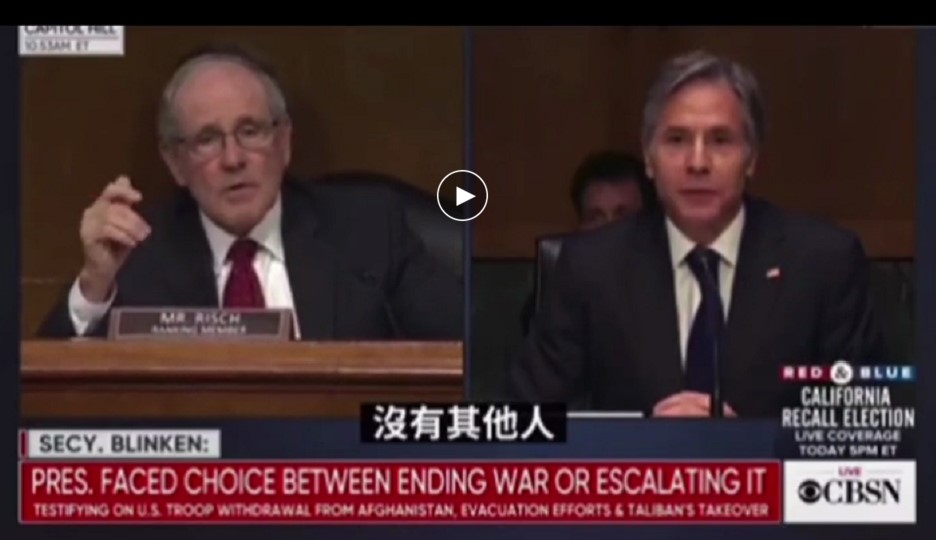
AUKUS agreement threatens peace in Asia
From HERE.
The security pact between the US, UK and Australia is a troubling reminder that these Anglo-Saxon powers are stuck in a Cold War mindset.
Earlier this month, the US, UK and Australia entered into a security pact to support Australia’s development and deployment of nuclear-powered submarines in the Pacific Ocean. The Australia-UK-US agreement (AUKUS) has been widely touted as an attempt to counter China’s ostensibly rising influence in the region and has been met with significant criticism from core players in the West, including France and Germany. More importantly, it has sent troubling reminders across Asian capitals of the outdated and imperial mindsets of its three partners.
There are two reasons that Asian nations are concerned. The first is the fear that this will lead to a creeping NATO-ization — a growing militarization and transformation of the region, especially South-East Asia, into a theatre of proxy conflicts. Second, it is led by an Anglo-Saxon alliance that appears stuck in a Cold War mentality that seeks to reinstate a Western imperial order in a region that fought long and hard to defeat it.
AUKUS is a slap in the face to Japan and India, which previously joined the US and Australia to counter China in the Quadrilateral Security Dialogue, known as the Quad. To them and other Asian nations, it should hopefully be the final reminder that there is no power-sharing with old imperial Western powers, who see themselves as masters of the universe, wrapped in a cloak of superiority to preserve their historical privileges. The generic statements from the US and Australia coming out of the Quad meeting in Washington last week point to the dialogue’s newfound uselessness.
AUKUS is not united, and it is not conducive to the preservation of peace in Asia and beyond. Instead, it is a haphazard assembly of disjointed, internally conflicting and externally expansionist Anglo-American interests. It must be rejected by Asian nations, who in the 21st century should no longer be seduced by disingenuous arguments about the need for security pacts led by non-regional players. Such pacts — designed to shore up and restore imperial objectives — belong to a different era.
From the Indo-Pacific to the Quad
Both AUKUS and its closely related counterpart, the Quad, have been viewed as a means of strengthening US regional ties and capacity to supposedly contain China’s maritime presence. In making sense of American strategy in the Indo-Pacific region, we must turn, briefly, to history.
The term “Indo-Pacific” was first coined in the 1920s by Karl Haushofer, a German army officer, intellectual and writer who sought to frame India and China as anti-colonial partners to Germany in its resistance efforts against Western Europe and the U.S. Despite occupying a significant share of the planet’s population, India and China were portrayed largely as passive instruments in the struggle for global domination between Germany and the rest of Europe. One should not forget, given the historical origins of these terms, the racist nature of the sentiments they embody.
The term was subsequently picked up by senior leaders in Japan and the US as a discursive motif highlighting the alleged stakes and interests these respective countries have in the Indian and Pacific Oceans. Through amalgamating the Indian and Pacific geopolitical spheres, “Indo-Pacific” subtly provides the legitimation basis for proposals that seek to constrain China’s actions in the region, while lending a veneer of natural credibility to alliances such as the Quad.
The past decade has seen a precipitous increase in the frequency of references to the “Indo-Pacific” in Western geopolitical discourse. Indeed, under President Donald Trump’s recent tenure, the term was brandished as both a threat and signal of the US commitment to marginalizing and excluding China from the global stage. China is portrayed as the natural enemy that binds together non-Chinese countries in the Indo-Pacific, even though the reality is far more complex.
This was where the Quad came in, first proposed in 2007 by Japan’s then-prime minister Shinzo Abe as a strategic dialogue between Japan, the US, India and Australia. The loose alliance among these four Indo-Pacific stakeholders was matched by significant joint military exercises, with the aim of exhibiting the joint strength of these states in the face of an ascendant China. Notably excluding China, the Quad was halted upon Kevin Rudd’s ascent to premiership of Australia. Rudd advocated a more pragmatic, savvy and moderate approach to Sino-Australian relations. He speaks Chinese and understands China better than many of his counterparts. He uniquely recognised that the alliance, despite amounting to little more than sound and fury, would serve to aggravate China and play into the hands of ultranationalist, militaristic hawks in the country.
The détente, unfortunately, did not last. Rudd’s multi-pronged and ends-driven engagement with China was discontinued after his tenure. Since then, a string of Sino-skeptic and pro-US prime ministers have been driving Australian foreign policy. Tensions between Beijing and Canberra, coupled with American geopolitical maneuvering in the region, culminated with the revival of the Quad in March 2021. Quad members called for “a shared vision for a free and open Indo-Pacific” and a “rules-based maritime order in the East and South China Seas.”
Australia — a country that, if not for its shared Anglo-Saxon settler history with Britain and the US, would be an insignificant player in global geopolitics — has used the Quad and the need for the US to have a Western ally in the Asia-Pacific region to stay relevant. In what will inevitably be a post-Western century, this is a big gamble, and it has only served to raise tensions in the Asia-Pacific region.
Seeking to counter and negate China’s claims over the South China Sea, the Quad resumed its mantle as an anti-China coalition. Beyond their shared partial skepticism toward China, the four member states have vastly disparate interests. India and Japan would be particularly vulnerable if tensions escalated with China, given their proximity to and economic interdependence with it.
As the only Quad nation to share a land border with China, India is keen to avoid a repeat of the Galwan Valley clashes in 2020 — the deadliest in 45 years along the Sino-Indian border. Indeed, the US and Australia’s clandestine turning to the UK as an additional partner should offer ample cause for alarm among India and Japan, given that there appears to have been little consultation with them beforehand. The AUKUS slap in the face will hopefully get these two Asian giants to walk away from the Quad, allowing it to be swept into the dustbin of history.
Why AUKUS was a grave misstep for its members
AUKUS also emerged out of the anxieties of a post-Brexit UK — one that had been decoupled (plausibly against its interest) from the umbrella and collective that is the European Union. In constructing a cogent foreign policy, Boris Johnson had a plethora of options. He could have engaged constructively with the US and China alike, playing the role of a savvy middleman and intermediary. He could have formed new ties with Latin America and South-East Asia, driving forth a flexible and multi-continental trade strategy. But though the imperial era is long over, Johnson opted to stick with a tribe of Western powers. In exchange for what he presumably viewed as the safest option — one that would yield the least resistance given the zeitgeist in Britain today — he abandoned whatever was left of Britain’s credibility among European nations. One can see shades of the decision to partner with the US in the illegal invasion of Iraq, another moment when Australia was there by their side.
In practice, Britain gains little from joining AUKUS. The UK not only aggravated China by solidifying the impression that it was pivoting away from constructive and open engagement — it also committed to a defensive pact in a region where the British navy has relatively limited comparative advantage. And the costs of this venture will be significant: stationing two navy patrol vessels in the region for five years poses a sizeable military undertaking, with rather unspecified end results.
For Australia’s part, in its desperation to be globally relevant by seeking American backing over pre-existing arrangements with France, it has substantially undercut its credibility and standing. Furthermore, given the pre-existing nuclear umbrella and sizable US navy presence in the region, it remains highly improbable that the additional nuclear submarines would offer Australian defensive capacities a measurable and substantial boost. As for the optical argument — that Australia may appear to be stronger — much of this would be easily parsed and dismissed by anyone who was in the know. For these submarines to pose an effective deterrent against expansionist or militaristic behaviours from any state, Australia must be demonstrably willing to deploy them in achieving its own military ends. The past six decades of Australian foreign policy offer few grounds for confidence that it would indeed take the initiative of doing so. At best, such submarines would be deployed as a proxy for American interests in the region. Yet, is that truly what the antipodean nation wants — to become a subservient vassal in the imperialist project of another country?
The US does not benefit much from this nascent alliance either. The unilateralist approach adopted by Washington has proven to be both jarring and alienating for core European players. Biden had largely banked upon what he believed was adequate goodwill between the US, France and Germany to cushion the blow — but his calculus was proven wrong. In a single stroke, Biden completely undermined his promise to the UN General Assembly last week that the US does not want another Cold War. But, ironically, he gave meaning to his statement that “America is back”.
France views Australia’s participation in the agreement as a de facto reneging upon the prior partnerships it has held with France throughout the years. And France took a dim view of the self-interestedness of American foreign policy. Indeed, the French foreign affairs minister called the new pact a “stab in the back”. (Let us also be clear, though, that, for France, this has nothing to do with geopolitics — this was all about billions of dollars in military sales.)
Germany raised concerns that the agreement, brokered in secret, has frayed the relationship between the US and Europe. That kind of discord will likely hamper the prospects for normalisation and de-escalation between China and the West. And the fact that the agreement covers so much ground — from underwater technologies and long-range strike capabilities to cyber anti-espionage and intelligence sharing — could also send a misleading signal that provokes China. The establishment of AUKUS has taken the US further away from — not closer to — calibrating a sensible US-China relationship.
Why AUKUS has opened a Pandora’s box for Asia
While much commentary has focused on reactions of countries in Europe and the Anglosphere, it is well worth noting that the population of the three member states in the AUKUS remains a distinct minority compared to the billions living in countries who are neither a part of AUKUS, nor, indeed, its intended beneficiaries. The largest state in India, Uttar Pradesh, has a population of more than 220 million — about nine times that of Australia, three times that of the entire UK.
First, while Washington has gone to painstaking lengths to emphasize that AUKUS and the Quad are mutually complementary, it can’t have its cake and eat it, too. Words pale in the face of truth — and the truth is that India and Japan have been largely caught off-guard by the US and Australia’s engagement of this nascent strategic alliance, which sits awkwardly in parallel to the Quad. For one, would Japan or India be compelled to take to the defense of British interests in the region, given the US and Australia straddle both? Alternatively, how should states seeking potentially deepened ties in geopolitical terms with Australia and the US — like Myanmar and Bangladesh — navigate the prospective tensions between Indian and British interests in the region? These questions remain heavily underexplored, yet require urgent addressing.
Secondly, South-East Asian countries have been kept largely in the dark about AUKUS’s plans, despite the recent visits paid by Vice President Kamala Harris to Vietnam and Singapore. The region’s largest country, Indonesia, has already expressed its displeasure. With a population more than 10 times that of Australia’s, Indonesia is a regional power Australia should reckon with and not dismiss as it seeks to curry favour with the U.S.
To say the least, it is clear that a vast majority of South-East Asian states neither benefit from, nor would they prefer, a world where they are compelled to take sides between the US and China. South-East Asia has been transformed into a proxy battlefield between these two powers, unwittingly and involuntarily. AUKUS will only serve to bolster the motivations on the part of both parties to seek and establish regional hegemony — which will be to the detriment of smaller and medium-sized states that must bear the brunt of the potential economic and military fallout.
The road to peace, and the roadblocks
At the core of American moves in the region lies a belief so conspicuous, it’s impossible to miss: that China’s rise poses a threat to American interests in Asia.
This statement is only true if America sees its interests in Asia as equivalent to American hegemony and imperialist dominance. China does offer a viable alternative to many regional stakeholders, both in terms of its economic multilateralism and its military and geopolitical support. Yet, it would be absurd to conclude, prematurely, that China’s ascent would completely thwart American interests. Waning American influence should not be viewed as being to the detriment of the country and the world alike.
This is not to say that South-East Asian states should thereby accede to the demands and whims of China. Smaller and medium-sized powers are right to hedge — to delicately strike the balance between embracing a rising China and capitulating to the entirety of China’s vision for the region. Yet, AUKUS does very little to ensure that China’s influence is rightfully managed. Instead, its moves would only instigate and provoke, thereby engendering far greater uncertainty.
The US, UK and Australia could learn something from the recently unveiled EU Strategy for Cooperation in the Indo-Pacific, a plan that seeks to combine a strengthened presence in the region with the maintenance of broadly amicable relations with China. The European Union has refrained from explicitly or rhetorically confronting China. While the fruits of that approach remain to be seen, there is at least one point of relative certainty: It grants China and the EU alike more leeway and manoeuvring room to navigate the increasingly complicated quagmire that is Asia and the west Pacific.
This article was first published by Noema.
An 7 October 2021 update
The major submarine deal between the USA, UK and Australia has been set in motion. This makes nuclear confrontation between the USA and both Russia and China very dangerously close. And amazingly… President Biden is unaware that it occurred.

Which has everyone trying to figure out what is going on.
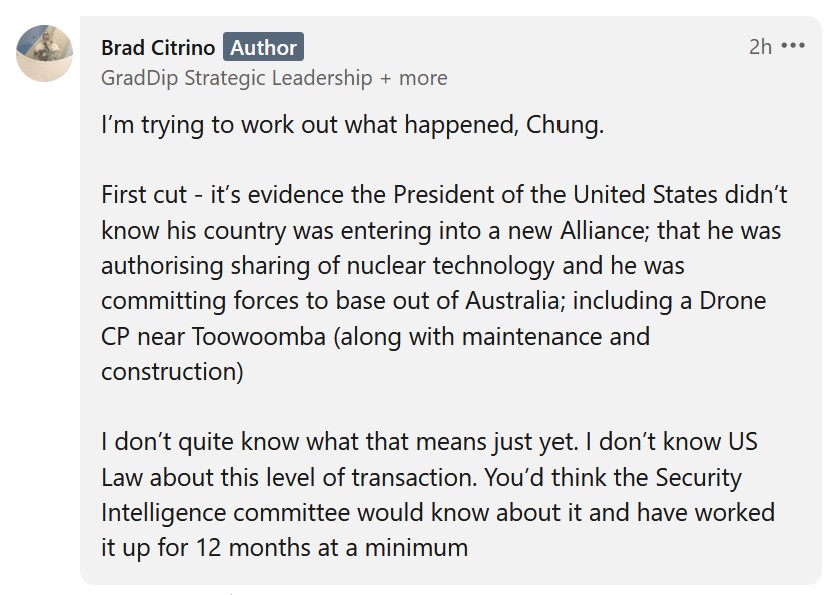
Let me tell you what is going on. There is no President. The Neocons on K-street are “running the country”. It’s going to get a shit-load of people killed.
Do you want more?
You can find more articles related to this in my latest index; A New Beginning. And in it are elements of the old, some elements regarding the transition, and some elements that look towards the future.
New Beginnings.
Articles & Links
Master Index.
- You can start reading the articles by going HERE.
- You can visit the Index Page HERE to explore by article subject.
- You can also ask the author some questions. You can go HERE to find out how to go about this.
- You can find out more about the author HERE.
- If you have concerns or complaints, you can go HERE.
- If you want to make a donation, you can go HERE.

